A Complete Optimization of the Red Wings Lineup Based on WAR
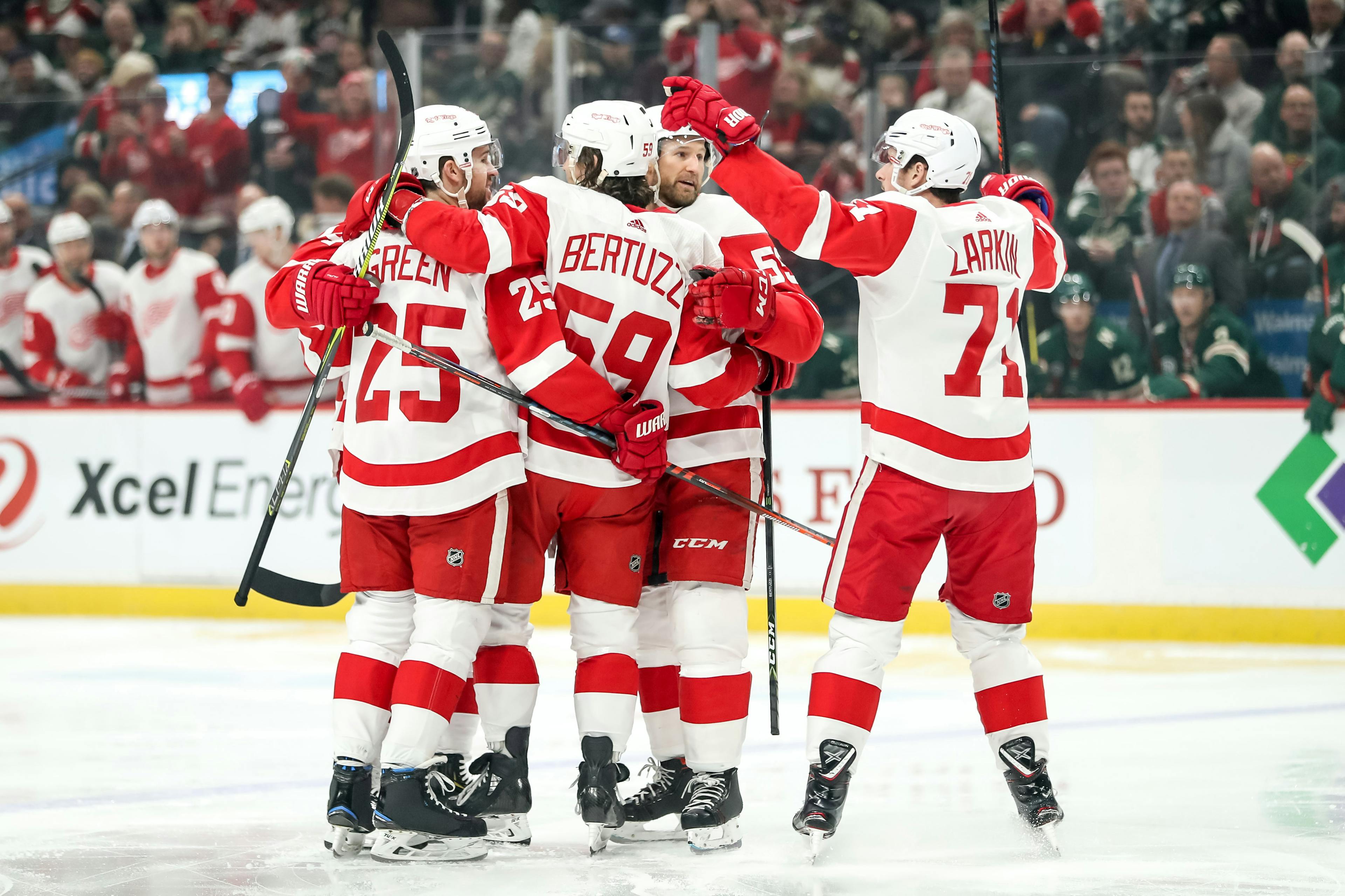
By Tony Ferrari
4 years agoA couple of weeks ago, fellow WingsNation writer Tom Mitsos wrote about what the opening night lineup could look like come October in comparison to what it looked like the year prior. The results were mixed. Yes, there was an improvement from last year’s opening night roster but it wasn’t going to be a huge jump. The reality of the situation is that the Red Wings are rebuilding and they will likely end up with a fairly inefficient roster that competes hard and plays the way head coach Jeff Blashill wants them to play, even if they do end up with poor results. For reference, here is the lineup that Tom put together on July 10th, 2019:

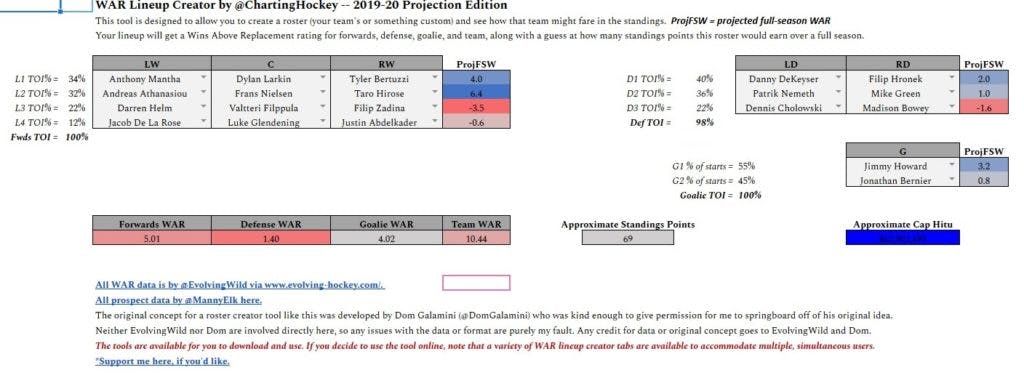
Point and WAR totals for 2019-20 season. (Chart via Sean Tierney)
As you can see, this is a lineup that we could very well see come October 5th in Nashville. Something that is quite obvious is that the lineup lacks optimization. Let’s be clear about something first off, Tom’s lineup here is pretty spot on. If I was projecting a lineup for opening night, it would look like something close to that if we’re being realistic. That is where the problem lies. Although realistic, how optimal is it? Not very.
The goal of this exercise is to take the current roster and prospects that seem to be on the cusp, figure out who should be in the lineup using WAR as our primary grading system and making the most optimized lineup that gets us the most “Approximate Standings Points” possible. While this is almost assuredly going to mean that this will not be a lineup that we see on the ice, for a variety of reasons that we will cover, it can be a fun exercise and it is July so the dog days of summer are here.
Let’s start here: What is WAR and how can it be used? WAR is a statistic that is somewhat similar to the baseball version by the same name. It’s meant to try to encompass a players full value based on their performance on the ice. While the hockey version of WAR is far less accurate due to the nature and unpredictability of the game, it still holds value. It shouldn’t be looked at as the be all and end all of a players value, because its not. It is one tool that can be used to get a broad view of a players value to the team.
Identifying Weak Spots
Now that we have that out of the way, let’s examine the “Realistic Roster” for opening nights weak spots. It is key to identify that players that are weighing the lines and pairings and bringing negative value. At that point we can begin to evaluate who would be better suited for that spot and adjusting the deployment of each line appropriately. Below is a table courtesy of Evolving Hockey which shows that Red Wings roster from last season, with their WAR. Right away we can address some issues with the roster and lineup construction.
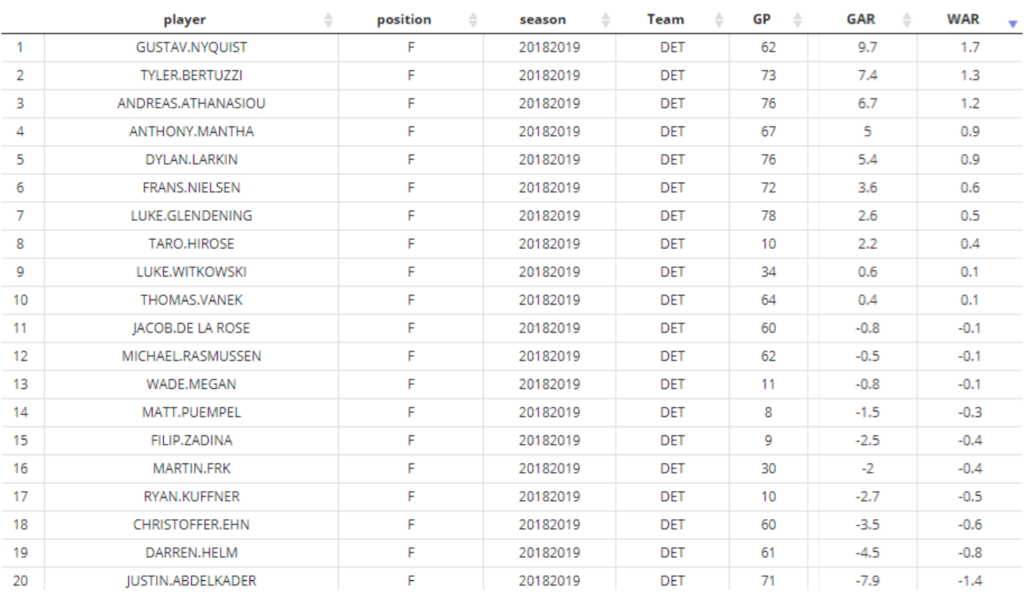
Red Wings WAR ratings courtesy of Evolving Hockey
Right away we notice that Justin Abdelkader is far and away the least valuable player when it comes to his WAR rating. His value decreases even more based on his deployment. When excluding Gustav Nyquist, he ranked 5th among Red Wings forwards in average time on ice. Playing him higher in the lineup or in a variety of situations like he was last year only makes his -1.4 WAR exponentially worse based on the increased playing time. This comes into play for the WAR Lineup Calculator because the line that a player on and the deployment of that line take into account WAR per minute. If the negative WAR player averages 15:23 TOI, whereas a player such as a replacement level player averages 11:23 TOI, that means that there is four minutes of negative value bringing down the team’s overall ability to produce. Its clear that, if possible, Abdelkader needs to be taken out of the lineup at all costs for the purposes of this exercise.
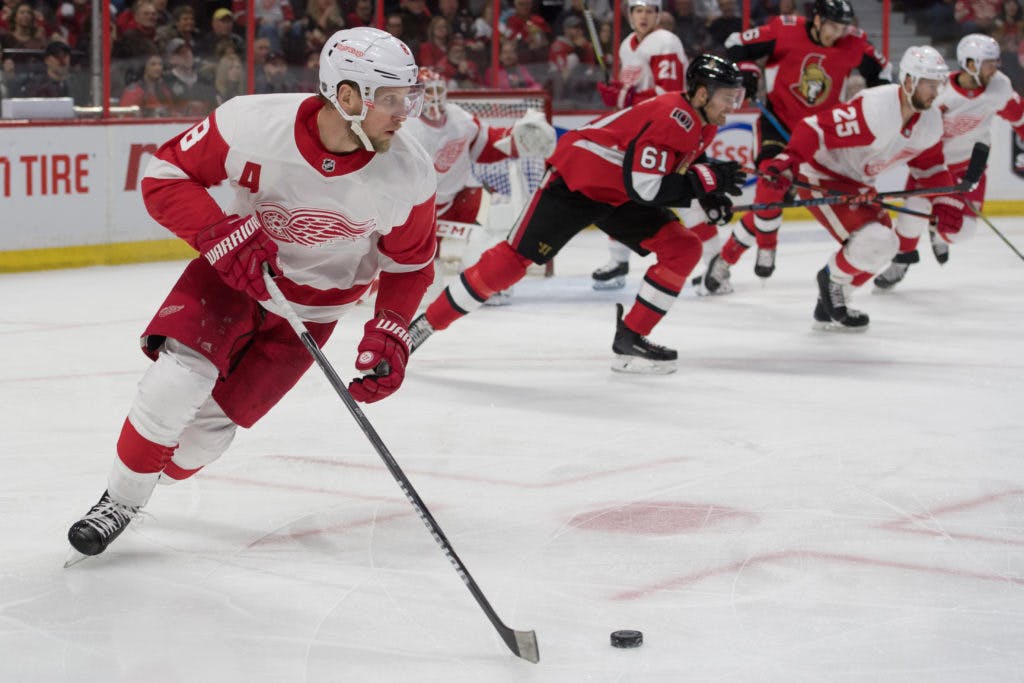
Feb 2, 2019; Ottawa, Ontario, CAN; Detroit Red Wings left wing Justin Abdelkader (8) skates with the puck in the second period against the Ottawa Senators at the Canadian Tire Centre. Mandatory Credit: Marc DesRosiers-USA TODAY Sports
Now that we have the biggest drag on the lineup taken out, we need to look at who has left the organization and where they fit into things. Free agent signings Valtteri Filppula and Patrick Nemeth both had positive WAR ratings of 0.6 and 0.7 respectively. This means that they will both help fill out the position groups that they will be joining without much of a question. We can also look at incoming rookies such as Joe Veleno and Filip Zadina. While Zadina did get some time with the Wings last year, he didn’t show particularly well and saddled himself with a -.04 WAR, albeit in a limited sample. Veleno on the other hand will be granted a “replacement level” rating which essentially works out to a WAR of 0. The only time I cheat on my own rules in this exercise is to make sure that Zadina will be in my lineup. The difference between Zadina and the player that would have been in his spot is almost negligible so I made a concession and inserted the 6th overall pick in the 2018 Draft into the lineup with the assumption that he will likely be at least replacement level. If that is the case, we can actually tack on a couple extra points to the final score.
Another group of players that we can safely take out are the departures from the team. Players like Thomas Vanek and Luke Witkowski are not going to be in the lineup this upcoming season, opening up roster spots and playing time for younger, cheaper and/or more efficient players. Taking all of these factors into account, we can begin to see what the roster will begin to look like in terms of the players on it. This leads us to the next step of putting the players in their positions and creating an optimized lineup.
Optimizing the Lineup
This is where the fun part begins. We now have the opportunity to play “Coach Blashill” and set the lineup with the most opportunity to create positive value. The goal is to build the lineup that accumulates the most “Approximate Standings Points” as calculated by the WAR Lineup Calculator. The lineup below does just that. After spending some time tinkering with the tool, changing the lineups in and out and making a variety of lineups that were downright terrifying, not in a good way. From here we will break down the position groups and analyze why each line will and won’t work both in reality and in theory.
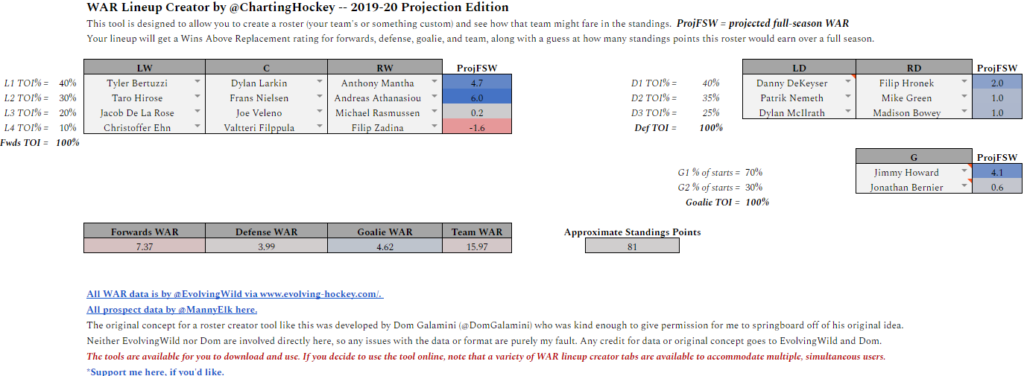
Point and WAR totals for 2019-20 season. (Chart via Sean Tierney)
Forwards
The top line should be exactly the way it is here. The Tyler Bertuzzi – Dylan Larkin – Anthony Mantha line was dominant in their time together. They finished the regular season last year as one of the hottest lines in hockey. While we can’t expect them produce at that 5.57 points per game pace like they did in their final seven games of the regular season, we can safely assume that they will be a productive top line. The second line is a line that could play together at some point this season. While it’s likely that Zadina gets an opportunity on the second line in place of Taro Hirose, if he plays on the third line this unit could work together. Filppula and Frans Nielsen are interchangeable in terms of value (0.6 WAR) so going with the incumbent on the second line makes sense. Andreas Athanasiou moving to the wings is key for this lines success. While he played well at times in the middle, his natural position is on the wing.
The third line is where the optimized lineup begins to get a little bit less realistic. Although Filppula is likely the center penciled in here in reality, Veleno is the man in the middle of this unit. His addition to the roster would inject even more youth. The likelihood of that happening is up in the air, but with a strong camp he could earn a spot on the Red Wings opening night roster. He showed that he has done everything he could in the QMJHL, his next step will likely be either on the wing of the third line in Detroit or as one of the top centers on the Griffins, depending on Steve Yzerman‘s plan. The wingers of Jacob De La Rose and Michael Rasmussen could both be destined for the Grand Rapids Griffins. Rasmussen should start the season with the Griffins so that he can work on his game and get playing time. Last season he was in the unfortunate position of being too young for the AHL and too good for the WHL. That left the Red Wings in the position of feeling the need to play him in the NHL, generally in a limited role. With the opportunity to get some AHL seasoning, Detroit should take advantage of that and allow Rasmussen to develop without the pressure and limited playing time he was limited by last season.
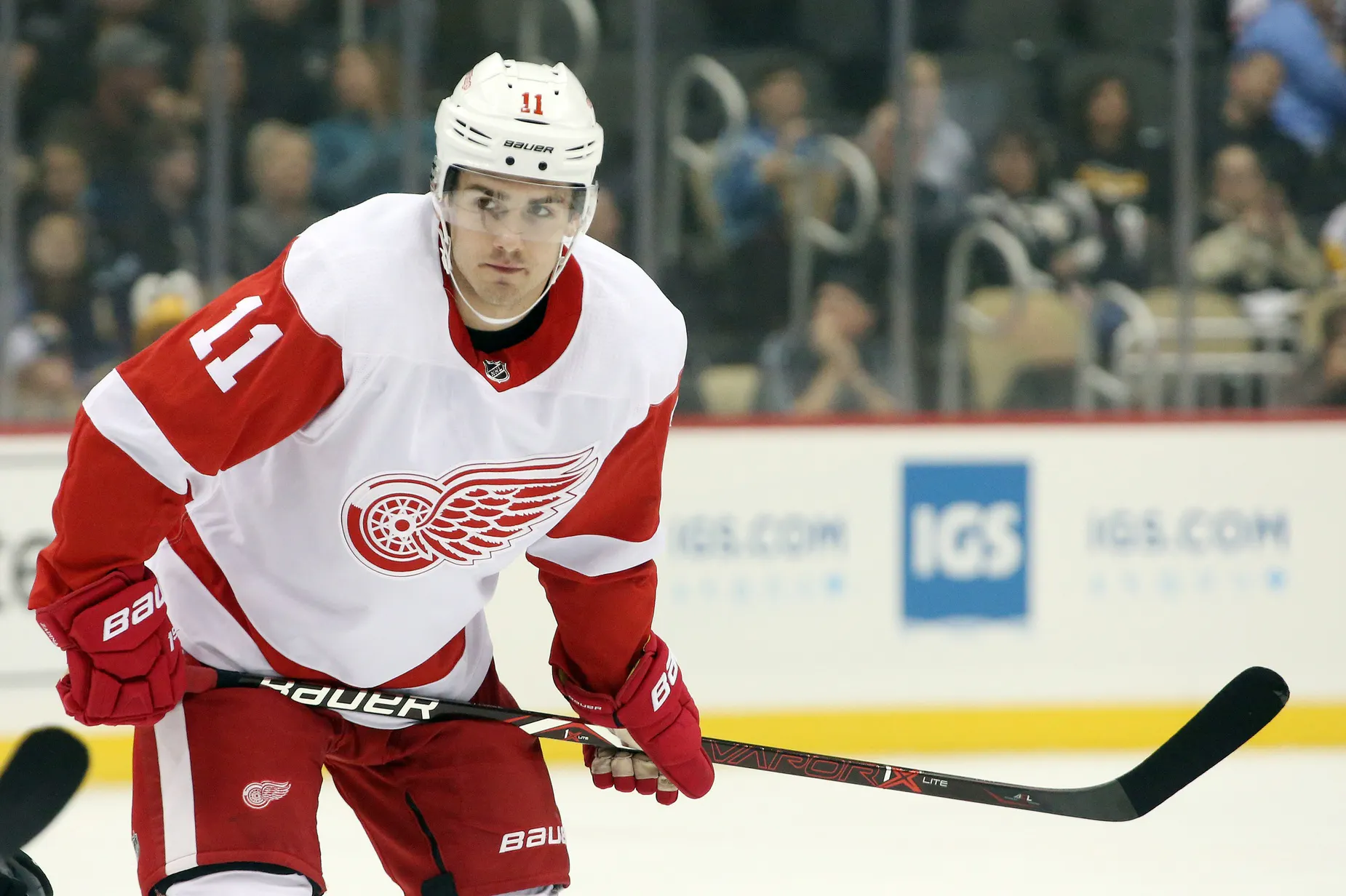
The fourth line is a bit of a weird one. This is where we’ve begun to run out of players that can provide positive-value players. With Filppula at center, he is the only player providing positive value on this line. Christoffer Ehn was the best among the rest when it came to fitting in on this line. The calculator preferred him at left wing over Ryan Kuffner. This is likely due to Ehn having the ability to play center and there isn’t much else there. Ehn has a realistic shot at being a contributor on the fourth line and will likely do a good job as a fourth line energy player. The real oddity of this line is that Filip Zadina had to be placed on the fourth line. He only received limited playing time and didn’t make a major impact in that time. This led to him accumulating a negative WAR value. As previously mentioned, if he does get playing time with the Wings, he will likely require a top-six role to truly succeed. He could get some time on the third line with the addition of Filppula. This projects as a more realistic third line than it does as a fourth. Zadina will require playing time and burying him on the fourth line won’t allow for that.
Overall, three of the four optimized lines (first, second and fourth) could all be fits in the lineup, with the optimized fourth being a realistic option as a third line. The third line is a little bit of a stretch considering Veleno is likely destined for Grand Rapids for some seasoning and development. Rasmussen may end up being on his wing in the AHL so this could be a slight look at the future as well. De La Rose could earn some time in the bottom-six or ride with the big club as the 13th forward. The fourth line could be a possibility as the third line at times this season as previously stated. Zadina is better suited to succeed more with skilled players higher in the lineup but some time on the third line is not out of the question with Blashill behind the bench. Overall, this line-up optimization did a couple of key couple of things up front. Abdelkader is out of the lineup, The skill is together near the top of the lineup and it allows young players to get into good positions to succeed.
Defence and Goaltending
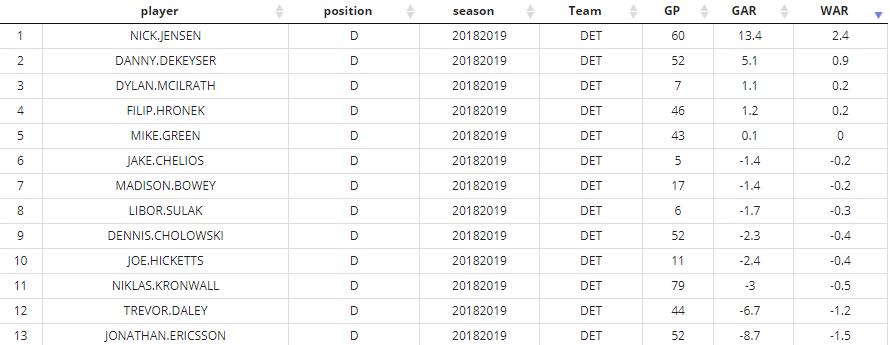
Red Wings WAR ratings courtesy of Evolving Hockey
This defensive alignment is actually not all that unbelievable. The top pairing of Danny Dekeyser and Filip Hronek will be the probable top pair heading into the season. Dekeyser had a resurgent season of sorts last year. Outside of Nick Jensen who was traded mid-season, Dekeyser led the Red Wings in WAR among defensemen. His return to respectability last year was a massive development for a team with more than a few contracts not providing appropriate value. The rest of the back-end was fairly easy to slot together. With a second pairing of newcomer Nemeth and Mike Green, the Red Wings will be able to put together a serviceable top-four. The third pairing could go in a variety of directions. With Dylan McIlrath making himself one of only four current Red Wings with a positive WAR value, he seemed like the logical choice for the one of the members of the bottom pair. This left the decision between two players. Jake Chelios and Madison Bowey. Tie goes to the veteran? Sort of. Bowey gets the nod because he played more NHL games than Chelios last season. Both players provided virtually the same value so it was a true toss up.
One glaring omission is 2016 first round pick Dennis Cholowski. This doesn’t mean that Cholowski is a worse player or less productive player than anyone that is currently in the top-six. What it means is that last year he played at a slightly below replacement level WAR as a 20-year-old player in the NHL. It’s expected that the young blue liner will get another shot at earning a roster spot come fall. Supplanting the likes of Jonathan Ericsson, Trevor Daley and the aforementioned McIlrath should not be an issue for Cholowski. The real issue will be whether or not the man behind the bench is able to give up his veteran defensemen in favour of the younger and more skilled “Cholo”.
When it comes to the netminders, it is as expected. Long-time starter Jimmy Howard retains the reins in net and veteran backup Jonathan Bernier will again wear the ball cap at the end of the bench. The reality of the situation in net is that it is better than most people think. Both Howard and Bernier have done a decent job in their roles and that shouldn’t change this upcoming season. The opportunity to trade Howard will again present itself at the deadline but on opening night, he should be in the crease for Detroit.
What Does This All Mean?
In the grand scheme of things, it means that the lineup isn’t optimized based on one statistic that isn’t universally valued. In July, it means a lot. It gives us an opportunity to take the roster, attempt to organize and optimize the lineup. It gives us the opportunity to see the “What If’s” and try to understand why coach Blashill makes the decisions he does and creates more questions than answers. Why is Abdelkader a staple in the lineup? Will the organization smarten up and move on, at least internally, from the likes of Daley and Ericsson? Are there prospects like Veleno and Zadina that could step in and make a difference? If they do move on from the “dead weight”, what does Detroit do with their combined $11.66 million cap hit?
The reality of the situation is that this team is more than likely going to go through another trying season. Even with the optimized lineup, the team finishes with 81 “Approximate Standings Points”. That would have placed them in a tie with the Vancouver Canucks for 23rd overall in the league. It would have them Jump the Buffalo Sabres in their division and still finished sixth in the Atlantic. Even optimized, this roster is far from finished. This doesn’t mean that the year is a waste of time because it will provide the opportunity to build a culture, develop young players and continue to allow the young guns to take on their leadership role, which includes giving Larkin the “C”.
The 2019-20 season will be another tough one Wings Nation. The best thing to do is enjoy the ride, hope your favorite player has a good season, hope the lottery balls are favorable and enjoy hockey.
Recent articles from Tony Ferrari





